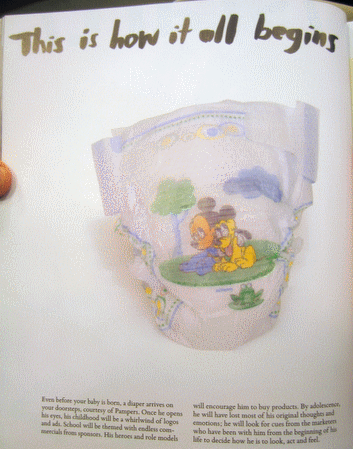 Each week I walk my two toddlers down the hall at the Children’s hospital, past a large statue of an over-stuffed yellow bird and up an elevator to our appointment. Sometimes they point out the “big birdie,” other times they don’t, it’s no more attractive to them than the nearby painting of a moose or the cars they see through the windows of the skyway.
Each week I walk my two toddlers down the hall at the Children’s hospital, past a large statue of an over-stuffed yellow bird and up an elevator to our appointment. Sometimes they point out the “big birdie,” other times they don’t, it’s no more attractive to them than the nearby painting of a moose or the cars they see through the windows of the skyway.
What they don’t know yet is that the big bird is, in fact, Big Bird. And though I’m sure someone will soon point it out to them (they’ve already learned who Elmo is), I’m in no rush to have Big Bird or any other media industry creations become my childrens’ branded pals.
What’s wrong with Sesame Street’s Big Bird? The show is certainly not as overtly problematic as Power Rangers or Barbie and the characters themselves don’t bother me particularly much. It’s all the other places they manage to show up that troubles me.
Grover is selling my kids diapers, Oscar is peddling fruit snacks, Big Bird is pimping shoes and Snuffleupagus . . . don’t get me started on Snuffleupagus. Licensing characters is a multi-billion dollar industry and although Sesame Street is not the worst offender, they milked Elmo for all they could when he became a smash hit in 1996 as a “tickle me” plush toy. Sesame Street is still a non-profit with support from the government and “viewers like you,” but 68 percent of it’s revenue comes from licensing.
An estimated $15 billion dollars is spent each year marketing to children under the age of 18 in the United States. That’s roughly $200 per child.
Using Elmo to sell my kid juice boxes isn’t the same as marketing to adults. Young children don’t understand the dynamics of persuasion. They don’t understand that the smiling kids on the commercial are paid actors following an elaborate script with the sole purpose of making little viewers want a product. They don’t understand that when their favourite character is munching on junk food that it’s a deceptive scheme, not an honest opinion. Kids think they’re watching Saturday morning cartoons, but to marketing execs the shows are “Program Length Commercials.”
Like most kids, I too grew up on these Saturday morning infomercials – Teenage Mutant Ninja Turtles, He-Man and Strawberry Shortcake. Though I turned out okay, as they say, I think I would have been better off with out them. I would have been less demanding of my parents and wouldn’t have spent the better part of my childhood being sold to. I don’t want my children to be victims of the deception
So when we pass the big yellow bird at the Children’s hospital next week, we might say hello but he’s not going to get any special treatment.
(This article was published in the summer issue of Geez Magazine, a rough draft had previously been posted on this site, but I realized I had not posted the final version for your viewing pleasure. Hope you enjoyed.)





